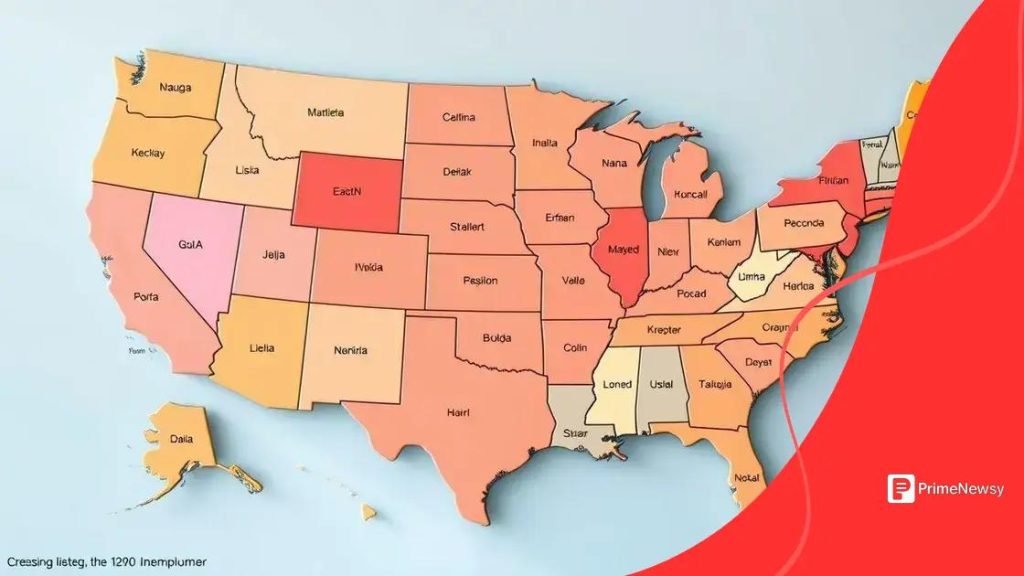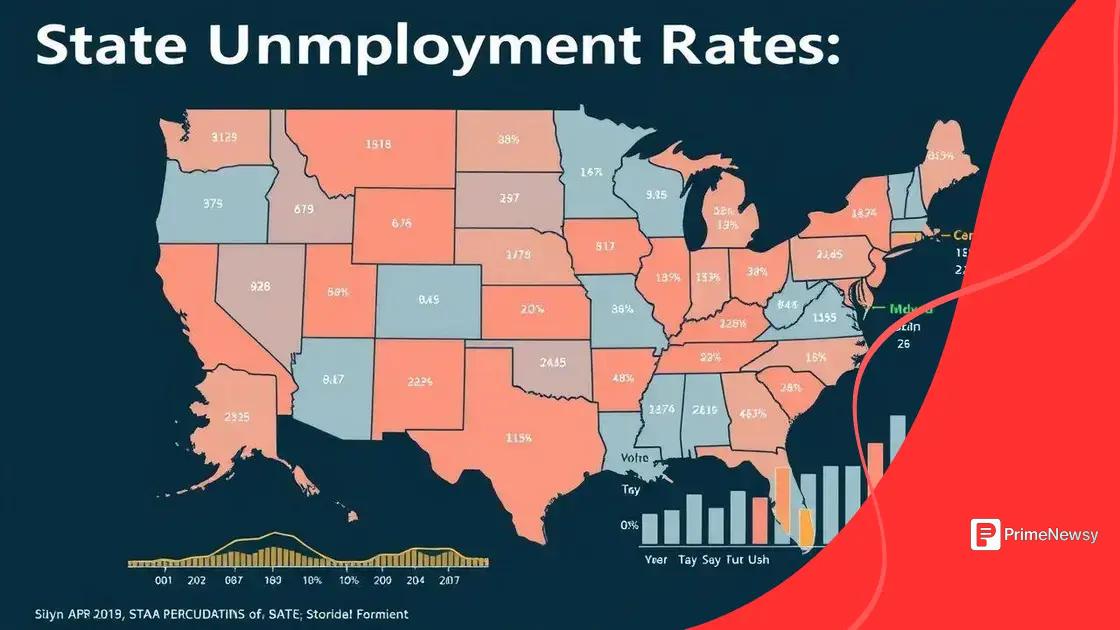Unemployment rates by state: what you need to know

Anúncios
Unemployment rates by state indicate economic health, influenced by factors like education, technological advancements, and government policies, affecting job availability and local economies significantly.
Unemployment rates by state offer a glimpse into the economic health of different regions. This data affects us all, whether we’re job hunting or gauging economic stability. What insights can we draw from the numbers?
Anúncios
Understanding unemployment rates
Understanding unemployment rates is crucial for grasping the economic health of a region. These rates indicate the percentage of the workforce that is unemployed and actively seeking work. They help us assess job availability and economic stability in different areas.
What Do Unemployment Rates Indicate?
Unemployment rates serve as a key indicator of economic performance. High rates may signal economic distress, while low rates reflect growth and opportunity. Understanding these shifts is vital for job seekers and policymakers alike.
Components of Unemployment Rates
Several factors contribute to calculating unemployment rates:
Anúncios
- The total labor force size
- The number of unemployed individuals looking for work
- External economic influences
These components provide a clearer picture of employment trends across different states.
Different states experience varying unemployment levels due to several conditions, including industry presence, educational opportunities, and economic policies. For instance, a state heavily reliant on tourism might see fluctuating unemployment rates based on the season. Critical economic events, such as the COVID-19 pandemic, highlighted how quickly these rates could change.
Analyzing State-by-State Variations
When analyzing unemployment rates across states, regional differences become evident. Some states maintain consistently low rates, thanks to diverse job markets, while others struggle with higher unemployment.
- Regions with tech industries often see lower unemployment.
- Agricultural states may experience seasonal job fluctuations.
- States investing in infrastructure often provide more job opportunities.
As we dive deeper into these variations, it’s important to consider factors such as local policies, education, and economic diversification. These elements shape the labor markets and influence the job rate in every state.
Understanding unemployment rates is essential for navigating the job market effectively. With insights into how these rates fluctuate, job seekers can make informed decisions. Likewise, businesses can strategize hiring practices based on trends. Ultimately, monitoring these rates is beneficial for all involved in the economy, as they reflect the health and potential of the job market.
Factors affecting unemployment by state
Several factors can significantly affect unemployment by state, and understanding these can provide insight into economic conditions. Different states face unique circumstances that influence their labor markets.
Economic Structure
The economic structure of a state plays a vital role in its unemployment rates. States with diverse economies often have lower unemployment rates. For instance, those that depend heavily on a single industry, like agriculture or manufacturing, can experience volatile job markets.
Education and Skill Levels
Education levels and the skill set of the workforce also impact unemployment. Areas with higher educational attainment tend to have better job opportunities. Employers usually seek skilled workers, meaning regions without a well-trained labor force may struggle with higher unemployment.
- High school graduation rates
- Access to vocational training
- Higher education institutions within the state
States that invest in education and training programs often see a decrease in unemployment. This investment prepares individuals for available jobs, aligning skills with market needs.
Geographic Location
The geographic location can also play a critical role in determining unemployment rates. States with easy access to major transportation hubs or urban centers typically have more opportunities. Conversely, rural areas may face challenges due to limited job availability.
Natural resources can create jobs as well. States rich in oil, minerals, or tourism often experience fluctuating unemployment based on industry demand. For example, an economic boom in oil production can reduce unemployment rates rapidly.
Government Policies
Government policies significantly shape employment landscapes. Policies supporting small businesses can create job opportunities, while regulations may hinder growth in certain industries.
- Minimum wage laws
- Business incentives
- Employment regulations
By analyzing these factors, we can gain a clearer understanding of the trends that affect unemployment in each state. Overall, multiple dynamics work together to create the complex picture of job availability.
Comparative analysis of state unemployment

A comparative analysis of state unemployment reveals significant differences across the United States. Understanding these disparities helps us see the broader economic picture and how each state is performing.
Variations in Unemployment Rates
Unemployment rates can vary widely from state to state. For example, some states consistently report low unemployment due to diversified economies. Others, however, face challenges that lead to higher rates.
States like California and Texas often show lower unemployment rates thanks to their strong tech and energy sectors. In contrast, states reliant on manufacturing may experience more volatile rates. This variation can provide insights into which regions are thriving economically and which are struggling.
Economic Indicators
To effectively compare unemployment, we must look at different economic indicators, including:
- Job creation statistics
- Industry growth
- Population changes
These indicators help to clarify why some states face higher unemployment levels. By analyzing job creation, we can see how industries flourish or fail.
Geographic and Demographic Factors
Geographic and demographic factors, too, play a significant role in shaping unemployment rates. For example, rural areas may find it challenging to attract businesses, resulting in fewer job opportunities. In contrast, urban areas usually have more economic activity, leading to more job openings.
Additionally, demographic shifts—such as age and education level—affect the local labor market. States with a younger educated workforce tend to adapt better to changes in job demands.
Longitudinal Studies
Longitudinal studies can offer valuable insight into unemployment trends over time. By tracking changes, we can understand how external events, like recessions or pandemics, influence unemployment. The COVID-19 pandemic, for instance, caused significant spikes in unemployment across the nation, revealing vulnerabilities in certain states.
By comparing state data over the years, it becomes clearer how quickly economies can recover or falter in response to various challenges. Analyzing these trends is vital for future planning and policy-making.
Impact of unemployment on local economies
The impact of unemployment on local economies is profound and multifaceted. When unemployment rates rise, they often lead to a cascade of effects that can hinder economic growth and stability.
Reduced Consumer Spending
High unemployment results in decreased consumer spending. When people are out of work, they have less disposable income to spend on goods and services. This reduction in spending can slow down local businesses, leading to lower revenues and potential closures.
Increased Dependence on Social Services
As unemployment rises, many families rely more on social services. This increased dependence can strain local government resources. More people may seek unemployment benefits, food assistance, and housing support.
- Higher demand for food assistance programs
- Increased applications for unemployment benefits
- Strain on public housing resources
When local governments allocate more resources to these programs, it can divert funds from other essential services like education and infrastructure improvement.
Effects on Local Businesses
Local businesses often feel the brunt of the economic downturn caused by rising unemployment. With fewer customers, these businesses may cut back on hiring or even lay off employees. This creates a cycle that can lead to further increases in unemployment.
Small businesses are particularly vulnerable to these changes. Without sufficient customer demand, they struggle to remain profitable, leading to closures and job losses. In turn, these closures can create a more desolate shopping environment, further deterring consumers.
Long-term Economic Stagnation
When communities experience prolonged periods of high unemployment, the effects can linger. Local economies may suffer from stagnation, making it challenging to recover even when job opportunities become available again.
Negative perceptions can also form around areas with consistently high unemployment, making it less attractive for businesses and investors. This perception can hinder revitalization efforts and slow the recovery process.
Understanding the interplay between unemployment and local economies is essential. By recognizing these challenges, communities can develop targeted strategies to address unemployment and its broad impacts.
Future trends in unemployment rates
Understanding the future trends in unemployment rates is essential for preparing for economic changes. As markets evolve, so do employment landscapes across the nation.
Economic Recovery Post-Pandemic
In the wake of the COVID-19 pandemic, many experts anticipate fluctuating unemployment rates as economies recover. Initially, rates may remain high due to lingering effects of layoffs and business closures. However, as industries adapt and reopen, an overall decrease in unemployment could be expected.
Adoption of Technology
The rapid adoption of technology in the workplace is transforming job markets. While technological advancements can create new job opportunities, they may also lead to job displacement in certain sectors. Industries like retail and manufacturing may see significant changes due to automation.
- Increased demand for tech-related jobs
- Decline in traditional manufacturing roles
- Shift toward remote work options
As this trend continues, workers will need to adapt by developing new skills to remain competitive in the job market.
Demographic Shifts
Demographic changes also play a role in shaping future unemployment trends. The aging population may impact labor force participation rates. As older workers retire, this can create job openings that younger generations can fill. However, if there is a mismatch in skills, unemployment may not decrease as quickly as desired.
Impact of Government Policies
Future government policies will significantly influence unemployment rates. By implementing programs that support job creation and training, states can mitigate high unemployment levels. Policies aimed at improving education and partnerships with local businesses can also foster employment opportunities.
Furthermore, understanding regional economic conditions will be vital for tailoring strategies that effectively lower unemployment rates. Targeted investments in high-demand industries can stimulate job growth.
As we look ahead, monitoring these trends will be essential. Communities and policymakers should remain vigilant in identifying challenges and opportunities that shape the future of work.
FAQ – Frequently Asked Questions about Unemployment Rates and Their Impact
What factors influence unemployment rates in different states?
Unemployment rates can be influenced by economic structure, education levels, geographic location, and government policies affecting job creation.
How does technology impact employment?
While technology can displace certain jobs, it also creates new opportunities in emerging fields, requiring workers to adapt and develop new skills.
What are some common effects of high unemployment on local economies?
High unemployment can lead to reduced consumer spending, increased dependence on social services, and negative impacts on local businesses.
How can communities prepare for future unemployment trends?
Communities can monitor job market trends, invest in education and training, and develop supportive policies to promote job creation.